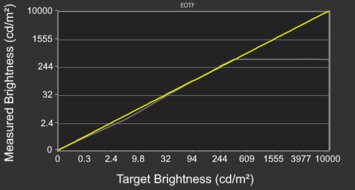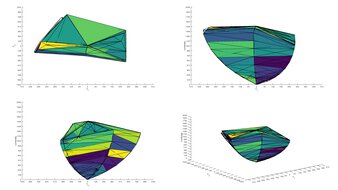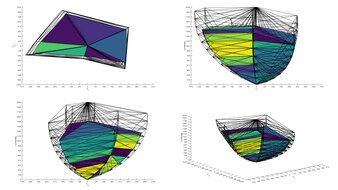Products
MSI MPG 271QRX QD-OLED
Gigabyte AORUS FO27Q3
Tested using Methodology v2.1.1
Updated Dec 02, 2025 01:21 PM
SEE PRICE
Amazon.com
Tested using Methodology v2.1.1
Updated Nov 07, 2025 02:19 PM
SEE PRICE
Walmart.com
Max Refresh Rate
360 Hz
Size
27"
Pixel Type
QD-OLED
Native Resolution
2560 x 1440
Max Refresh Rate
360 Hz
Size
27"
Pixel Type
QD-OLED
Native Resolution
2560 x 1440
Our Verdict
MSI MPG 271QRX QD-OLED
Gigabyte AORUS FO27Q3
The MSI MPG 271QRX QD-OLED and the Gigabyte AORUS FO27Q3 are similar monitors that have the same panel and many of the same features. The biggest difference is that the Gigabyte has lower input lag regardless of firmware, as you need to update the MSI's firmware to get the lowest input lag. On the other hand, the MSI delivers more power over USB-C, which is great if you want to connect a laptop.
Variants
- MPG 271QRX QD-OLED (27")
- AORUS FO27Q3 (27")
Check Price
27"
MPG 271QRX QD-OLED
SEE PRICE
Amazon.com
27"
AORUS FO27Q3
SEE PRICE
Walmart.com
27"
MPG 271QRX QD-OLED
SEE PRICE
BestBuy.com
27"
AORUS FO27Q3
SEE PRICE
Amazon.com
27"
MPG 271QRX QD-OLED
SEE PRICE
Walmart.com
27"
AORUS FO27Q3
SEE PRICE
B&H
27"
MPG 271QRX QD-OLED
SEE PRICE
B&H
27"
AORUS FO27Q3
SEE PRICE
BestBuy.com
Main Differences for
PC Gaming
PC Gaming
Threshold
PC Gaming
9.2
9.3
Full Comparison
Design
Accelerated Longevity Test
Uniformity Pictures


Longevity Graph
Ergonomics
9.0
9.0
Height Adjustment
4.3" (11.0 cm)
5.1" (13.0 cm)
Min Height To Top Of Panel
16.7" (42.3 cm)
15.5" (39.4 cm)
Tilt Range
-20° to 5°
-20° to 7.5
Rotate Portrait/Landscape
Yes, Both Ways
Yes, Clockwise
Swivel Range
-30° to 30°
-20° to 20°
Wall Mount
VESA 100x100
VESA 100x100
Picture Quality
Local Dimming
10
10
Local Dimming Video
Local Dimming
No
No
Backlight
No Backlight
No Backlight
SDR Brightness
6.9
7.8
Real Scene
245 cd/m²
319 cd/m²
Peak 2% Window
254 cd/m²
1,007 cd/m²
Peak 10% Window
252 cd/m²
456 cd/m²
Peak 25% Window
254 cd/m²
363 cd/m²
Peak 50% Window
256 cd/m²
307 cd/m²
Peak 100% Window
256 cd/m²
258 cd/m²
Sustained 2% Window
253 cd/m²
1,000 cd/m²
Sustained 10% Window
251 cd/m²
454 cd/m²
Sustained 25% Window
254 cd/m²
360 cd/m²
Sustained 50% Window
255 cd/m²
305 cd/m²
Sustained 100% Window
254 cd/m²
256 cd/m²
Automatic Brightness Limiting (ABL)
0.001
0.001
Minimum Brightness
27 cd/m²
20 cd/m²
HDR Brightness
7.0
6.9
VESA DisplayHDR Certification
DisplayHDR TRUE BLACK 400
DisplayHDR TRUE BLACK 400
Real Scene
459 cd/m²
441 cd/m²
Peak 2% Window
1,045 cd/m²
1,044 cd/m²
Peak 10% Window
476 cd/m²
472 cd/m²
Peak 25% Window
375 cd/m²
374 cd/m²
Peak 50% Window
316 cd/m²
316 cd/m²
Peak 100% Window
265 cd/m²
266 cd/m²
Sustained 2% Window
1,038 cd/m²
1,038 cd/m²
Sustained 10% Window
474 cd/m²
470 cd/m²
Sustained 25% Window
373 cd/m²
372 cd/m²
Sustained 50% Window
314 cd/m²
314 cd/m²
Sustained 100% Window
264 cd/m²
264 cd/m²
Automatic Brightness Limiting (ABL)
0.078
0.078
Color Accuracy (Pre-Calibration)
8.3
9.0
Picture Mode
sRGB
sRGB
sRGB Gamut Area xy
110.1%
105.2%
White Balance dE (Avg.)
0.99
1.15
Color Temperature (Avg.)
6,238 K
6,503 K
Gamma (Avg.)
2.25
2.26
Color dE (Avg.)
1.75
1.06
Contrast Setting
N/A
N/A
RGB Settings
Default
Default
Gamma Setting
No Gamma Setting
Default
Brightness Setting
70
32
Measured Brightness
217 cd/m²
98 cd/m²
Brightness Locked
No
No
Color Accuracy (Post-Calibration)
9.7
9.7
Picture Mode
User
Custom
sRGB Gamut Area xy
101.7%
101.1%
White Balance dE (Avg.)
0.51
0.55
Color Temperature (Avg.)
6,492 K
6,546 K
Gamma (Avg.)
2.19
2.19
Color dE (Avg.)
0.50
0.36
Contrast Setting
70
50
RGB Settings
97-99-100
96-98-100
Gamma Setting
No Gamma Setting
2.2
Brightness Setting
27
35
Measured Brightness
101 cd/m²
100 cd/m²
Viewing Angle
10
10
Viewing Angle Video
Color Washout From Left
70°
70°
Color Washout From Right
70°
70°
Color Shift From Left
70°
70°
Color Shift From Right
70°
70°
Brightness Loss From Left
70°
70°
Brightness Loss From Right
70°
70°
Black Level Raise From Left
70°
70°
Black Level Raise From Right
70°
70°
Gamma Shift From Left
70°
70°
Gamma Shift From Right
70°
70°
Direct Reflections
7.0
7.2
Direct Reflections Graph
Peak Direct Reflection Intensity
24.9%
23.3%
Screen Finish
Glossy
Glossy
Ambient Black Level Raise
4.3
3.9
Ambient Black Level Raise Graph
Black Luminance @ 0 lx
0.00 cd/m²
0.00 cd/m²
Black Luminance @ 1000 lx
3.39 cd/m²
3.70 cd/m²
Motion
Refresh Rate
8.4
8.4
Native Refresh Rate
360 Hz
360 Hz
Max Refresh Rate
360 Hz
360 Hz
Max Refresh Rate Over DP
360 Hz
360 Hz
Max Refresh Rate Over HDMI
360 Hz
360 Hz
Max Refresh Rate Over DP @ 10-bit
360 Hz
360 Hz
Max Refresh Rate Over HDMI @ 10-Bit
360 Hz
360 Hz
DSC Toggle
Yes
No
DSC Off Max Refresh Rate Over DP
240 Hz
N/A
DSC Off Max Refresh Rate Over HDMI
360 Hz
N/A
Variable Refresh Rate (VRR)
Variable Refresh Rate
Yes
Yes
FreeSync
Compatible (Tested)
Yes
G-SYNC
Compatible (Tested)
Compatible (Tested)
VRR Maximum
360 Hz
360 Hz
VRR Minimum
< 20 Hz
< 20 Hz
VRR Supported Connectors
DisplayPort, HDMI
DisplayPort, HDMI
VRR Motion Performance
9.9
9.9
OD Mode CAD Comparison
Recommended VRR OD Setting
No OD Mode
No OD Mode
Variable Overdrive Advertised
No
No
Avg. CAD
12
13
Best CAD
11
13
Worst CAD
20
13
Refresh Rate Compliance
9.7
9.7
Fast GTG Sequence
VRR Compliance
Compliance @ Max Hz
91%
87%
Compliance @ 120 FPS
96%
96%
Compliance @ 60 FPS
97%
96%
Response Time @ Max Refresh Rate
First Response Time
0.3 ms
0.3 ms
Total Response Time
0.3 ms
0.3 ms
Recommended Overdrive Setting
No OD Mode
No OD Mode
RGB Overshoot
0 RGB
0 RGB
Worst 10% RGB Overshoot
0 RGB
0 RGB
Worst 10% First Response Time
0.9 ms
0.5 ms
Worst 10% Total Response Time
0.9 ms
0.5 ms
Response Time @ 120Hz
Worst 10% First Response Time
0.7 ms
0.5 ms
RGB Overshoot
0 RGB
0 RGB
Total Response Time
0.3 ms
0.3 ms
First Response Time
0.3 ms
0.3 ms
Recommended Overdrive Setting
No OD Mode
No OD Mode
Worst 10% Total Response Time
0.7 ms
0.5 ms
Worst 10% RGB Overshoot
0 RGB
0 RGB
Response Time @ 60Hz
Recommended Overdrive Setting
No OD Mode
No OD Mode
First Response Time
0.3 ms
0.3 ms
Total Response Time
0.3 ms
0.3 ms
RGB Overshoot
0 RGB
0 RGB
Worst 10% Total Response Time
0.7 ms
0.5 ms
Worst 10% First Response Time
0.7 ms
0.5 ms
Worst 10% RGB Overshoot
0 RGB
0 RGB
Backlight Strobing (BFI)
Backlight Strobing (BFI)
No BFI
No BFI
Maximum Frequency
N/A
N/A
Minimum Frequency
N/A
N/A
Longest Pulse Width Brightness
N/A
N/A
Shortest Pulse Width Brightness
N/A
N/A
Pulse Width Control
No BFI
No BFI
Pulse Phase Control
No BFI
No BFI
Pulse Amplitude Control
No BFI
No BFI
VRR At The Same Time
No BFI
No BFI
Inputs
Input Lag
9.2
9.1
Native Resolution @ Max Hz
1.9 ms
2.1 ms
Native Resolution @ 120Hz
5.7 ms
5.5 ms
Native Resolution @ 60Hz
14.5 ms
13.9 ms
Backlight Strobing (BFI)
N/A
N/A
Resolution
7.5
7.5
Native Resolution
2560 x 1440
2560 x 1440
Aspect Ratio
16:9
16:9
Megapixels
3.7 MP
3.7 MP
Pixel Density
109 PPI
109 PPI
Inputs
DisplayPort
1 (DP 1.4)
1 (DP 1.4)
DisplayPort Transmission Bandwidth
No DisplayPort 2.1
No DisplayPort 2.1
Mini DisplayPort
No
No
HDMI
2 (HDMI 2.1)
2 (HDMI 2.1)
HDMI 2.1 Bandwidth
48Gbps (FRL 12x4)
48Gbps (FRL 12x4)
Daisy Chaining
No
No
3.5mm Audio Out
Yes
Yes
Ethernet
No
No
HDR10
Yes
Yes
Dolby Vision
No
No
USB
USB-A Ports
2
2
USB-A Rated Speed
480Mbps (USB 2.0)
5Gbps (USB 3.2 Gen 1)
USB-B Upstream Port
Yes
Yes
USB-C Ports
1
1
USB-C Upstream
Yes
Yes
USB-C Rated Speed
5Gbps (USB 3.2 Gen 1)
5Gbps (USB 3.2 Gen 1)
USB-C Power Delivery
90W
18W
USB-C DisplayPort Alt Mode
Yes
Yes
Thunderbolt
No
No
Features
Additional Features
Speakers
No
Yes
RGB Illumination
Presets
Presets
Multiple Input Display
PIP + PBP
PIP + PBP
KVM Switch
Yes
Yes
Smart OS
No
No
Check Price
27"
MPG 271QRX QD-OLED
SEE PRICE
Amazon.com
27"
AORUS FO27Q3
SEE PRICE
Walmart.com
27"
MPG 271QRX QD-OLED
SEE PRICE
BestBuy.com
27"
AORUS FO27Q3
SEE PRICE
Amazon.com
27"
MPG 271QRX QD-OLED
SEE PRICE
Walmart.com
27"
AORUS FO27Q3
SEE PRICE
B&H
27"
MPG 271QRX QD-OLED
SEE PRICE
B&H
27"
AORUS FO27Q3
SEE PRICE
BestBuy.com


































































































































MSI MPG 271QRX QD-OLED
Gigabyte AORUS FO27Q3
Comments
MSI MPG 271QRX QD-OLED vs Gigabyte AORUS FO27Q3: Main Discussion
What do you think of these products? Let us know below.
Looking for a personalized buying advice from the RTINGS.com experts? Insiders have direct access to buying advice on our insider forum.
Yeah, weirding me out too as I can find the FO27Q3 cheaper more consistently then the 271QRX (plus the FO27Q3 has nice to haves like speakers) The only major upsides of the 271QRX are the 90W USB PD and the much more low profile stand, otherwise the FO27Q3 seems to be the better option
But why are you recommending the MSI and not the AORUS?
Hi, the prices of monitors can vary a bit over time. Both monitors have a non-sale price of around $800 US, but as one or the other goes on sale one will go below the price of the other. As we say in our Best 27-Inch Gaming Monitors recommendation, the FO27Q3 “has many of the same features and performs similarly, so it’s worth getting if you can find it for less than the MSI. That said, it’s harder to find at times.”
The Gigabyte is better (although marginally) in almost every scenario, and also cheaper in my country. Also SDR Brightness and VRR Flicker is better on the Gigabyte. But then why isn’t it recommended as the best 27" monitor in your best OLED monitors while the MSI MPG is? Kinda puzzled.